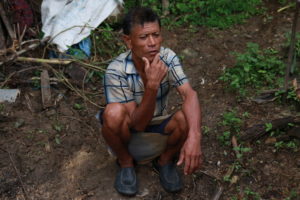Grace in adversity

Slowly and carefully, through mud and landslide debris, I walked along a remote and desolate road in Bhotechaur, hoping to find people who had previously received emergency earthquake relief distributions. Bhotechaur is a small, mountainside village in the very remote outskirts of central Nepal. The houses were spread far apart, and I could see both quake-damaged remains of homes, and makeshift shelters scattered along the mountainside road.
Finally, I spotted a solitary figure, busily working around (what appeared to be) the remains of a damaged house. Shovana (my translator and young Nepali friend) introduced us, and we struck up a conversation with Rana Tamang, who smiled and opened up easily about his life and his situation. Rana told us that he is a farmer, with 4 members in his family – his mother, wife, son and daughter. His son is studying in Kathmandu, but his daughter stays with him, his wife and his mother in the temporary shelter that they constructed after the earthquake.
 In fact, Rana and his family lost a two-story house – the damaged structure that we had first found him standing near when we spotted him from the road. He now lives with his family in a small, temporary shelter made of tin that stands very close to the rubble of his damaged home. I remember my feeling of amazement in considering that this flattened structure had once provided two full levels of living space, and I silently said a prayer of gratitude that none of them happened to be inside the house on the day of the quake.
In fact, Rana and his family lost a two-story house – the damaged structure that we had first found him standing near when we spotted him from the road. He now lives with his family in a small, temporary shelter made of tin that stands very close to the rubble of his damaged home. I remember my feeling of amazement in considering that this flattened structure had once provided two full levels of living space, and I silently said a prayer of gratitude that none of them happened to be inside the house on the day of the quake.
Despite his tired eyes, Rana smiled as he spoke, and insisted that we sit on chairs carried out of their shelter by his wife. Rana’s wife rushed out to meet us when she spotted us with Rana, and then she hurried back into their temporary home to prepare roasted corn for us. She continued to serve with incredible generosity throughout our visit, insisting: “Please, we are happy to have you as our guest; take more!” We learned from Rana’s wife that these corns were the only production from their land now, and they are the only means they have presently to make a living.
As Rana continued to speak with us, I was struck by his simple gratitude – despite all the hardship and struggle that his family’s life had been reduced to, he was always focused on the positive: “I am very thankful for this temporary shelter. It is small and difficult, and my daughter tries to study here. But things have been better since we received our tarps. The monsoon rains had begun to cause the tin roof to leak, but now that has stopped because I spread the tarps over the roof. It is better now.”
 At one point, Rana proudly displayed his Government issued Earthquake Victim card. Although he is uncertain about the government’s support that is promised for reconstruction of his home, he said that this card is an important link for his family to the small measures of post-quake relief that have been available to him in Bhotechaur. He said, “It has been the NGOs who have helped us most at this time. You have been here for us. I have faith in you.”
At one point, Rana proudly displayed his Government issued Earthquake Victim card. Although he is uncertain about the government’s support that is promised for reconstruction of his home, he said that this card is an important link for his family to the small measures of post-quake relief that have been available to him in Bhotechaur. He said, “It has been the NGOs who have helped us most at this time. You have been here for us. I have faith in you.”
Before we departed, I turned to Rana and asked about his hopes and ideas for the future. Again, he smiled, and said simply that it was his dream to rebuild his home. He said that with construction materials, he would happily rebuild his house by himself. Like the other survivors I would meet on the road in Bhotechaur this day, Rana and his family are living a “suspended life” right now, and their hearts and minds are focused on the singular goal to rebuild their home. Indeed, a house is so much more than wood and stone – it is a place of comfort, solace and belonging, which provides structure and certainty to a family’s life.
The people of Nepal are looking forward now with determination in their hearts, despite the struggles and losses they have experienced. As such, they are profound examples of the grace with which we can choose to walk through the trials and tribulations of life.
~~~~~~~~~~~~~~~~~~
[I wrote this story on September 3, 2015 in reflection of relief distribution trip to Bhotechaur – a small, mountainside village in the very remote outskirts of Sindhupalchok District. At that time, I was working with Medair, a disaster relief agency, and I was based in post-earthquake Nepal.]